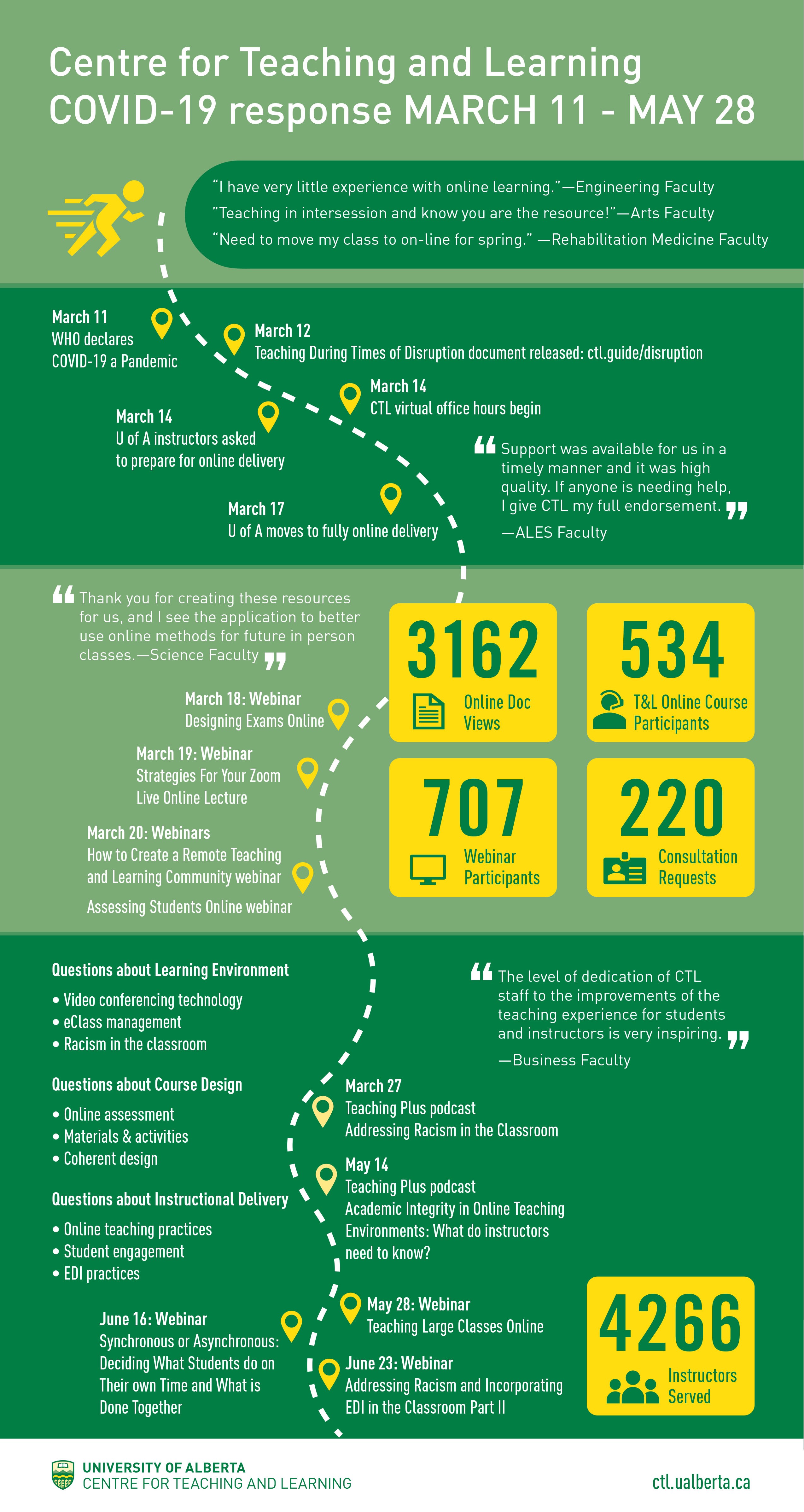
This is Part Four in the Centre for Teaching and Learning’s four-part series, Teaching Online. Read Part One: Coming Out of Crisis Mode: Bettering the Remote Learning Environment, Part Two: The Most Common Questions for Teaching Online, and Part Three: Academic Integrity in Online Teaching Environments.Teaching Online. Read Part One: Coming Out of Crisis Mode: Bettering the Remote Learning Environment, Part Two: The Most Common Questions for Teaching Online, and Part Three: Academic Integrity in Online Teaching Environments.
Friday the 13th: traditionally the most unlucky day in the Gregorian calendar and the American movie industry (Alfred Hitchcock was even born on Friday the 13th). This year, Friday the 13th in March was the day I realized the Centre for Teaching and Learning (CTL) and instructors across our university were about to step beyond our comfort zones to deliver courses in new ways.
Many instructors had initially hoped to replicate the in-person experience of teaching and learning in a video conference; instructors have since realized that learning to teach our courses remotely from home was (and continues to be) a significant shift. As an Educational Developer, a “teaching coach,” at CTL I can appreciate the anxiety, apprehension, and healthy skepticism that accompanies this shift. The pressure to get classes online quickly has been the impetus (or “spur,” as one instructor told me) to stretch ourselves in new ways of teaching and relating with our students. We can model positive responses to uncertainty and change through our efforts and our interactions with our students in our courses.
Between March 11 and May 28, CTL served 4,266 instructors’ requests for information and strategies for teaching remotely. CTL’s self-paced Teaching and Learning Online course has over 534 participants. This week, I’m offering a Teaching Large Classes Online webinar. Within 24 hours, 178 instructors had signed up and 334 participants have registered.

Since March 13 CTL has worked with hundreds of instructors creating videos for their courses for the first time. I’ve carefully reminded some instructors that it’s not a good use of their time to record a video over and over again until they get it just so. It’s more efficient for instructors and more manageable for students when instructors create 10 or 15 minute pre-recorded lecture episodes. We aren’t actors, even if it feels like a bit of a performance sometimes. (Besides, the makeup artists and hair stylists are unavailable.)
I’ve also met many instructors who are teaching while being pulled in numerous directions by responsibilities at home during social isolation. I experience deep compassion when an instructor appears in a video conference from their basement, next to the washer and dryer with laundry hanging in the background, whispering, “If we speak very quietly, my children won’t find us.” Zoom backgrounds may have saved our sense of professionalism on video, but the challenges remain even if they are hidden.
Few of us were prepared for these new realities. While teaching from home via videoconferencing, I can no longer move around the room while I teach (at least not very far); I see myself mirrored on the screen (which I’ll admit is distracting at times); and I feel the muscles in my face grow stronger each week for all my exaggerated facial expressions I make when video conferencing (unfortunately this is not eliminating my wrinkles and laugh lines).
I’ll admit that seeing rows and rows of students in tiny video boxes is intimidating at first, particularly in highly relational courses. My colleague Jen Ward, Educational Developer (Indigenous Focus) reminded me that humans have sat in circles to have meaningful discussions and make thoughtful decisions for thousands of years. Today, we’re teaching and learning from inside wee boxes on a screen.
Nonetheless, we are adapting. We are doing it. It’s happening.
Instructors across departments and faculties are learning to:
- Share or deliver content with their students through pre-recorded videos that students can watch anytime
- Foster discussion through asynchronous discussion boards in eClass and synchronously through video conferencing platforms
- Unpack content, solve a problem, or conduct a case study in breakout rooms during a synchronous class
- Encourage student teams or groups to work together in a google doc or a separate video conference for project work
- Take exams in new formats and clarify what academic integrity means in the process
Learning to teach remotely ultimately means we relinquish some power and control over the virtual classroom — relinquish the comfort of the familiar. The instructor’s role is increasingly one of a guide, facilitator, and coach to students’ participation with the content, with the instructor, and with each other. We aren’t actors on the Zoom Show. We are giving our best where we are (including in the basement next to the washing machine) and in our own process of learning to teach online. The reality is that when it comes to online courses, most instructors are learning to build the airplane as they fly it. Life beyond our teaching comfort zone continues.
The Centre for Teaching and Learning is rooting for you in the process.

Cosette Lemelin— Educational Developer, Centre for Teaching and Learning
Cosette has 16 years of experience in Educational Developer roles in a 20-year career in adult and post-secondary education at three universities (the University of Winnipeg, the University of Manitoba, and the University of Alberta). She has a Master of Education (2003) and PhD in Education (2016) focusing on adult and post-secondary education. Cosette’s unique specialities include teaching within health professions education (with a focus on clinical practicum teaching and learning), classroom management, and varying aspects of interpersonal communication in teaching and learning. Cosette calls herself a “Teaching Coach” for university instructors and faculty members striving to improve their teaching one class, one activity, or one interaction at a time. Cosette is the lead on the Teaching Development Program (TDP), Teaching Labs, and Inspiring Teaching. Cosette is the Vice-Chair, Conferences on the Educational Developer Caucus (EDC) national Executive. Cosette is the 2019 recipient of the University of Alberta Excellence in Learning Support Award.